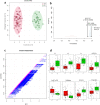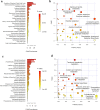Distinct serum metabolomic signatures of multiparous and primiparous dairy cows switched from a moderate to high-grain diet during early lactation
- PMID: 32909121
- PMCID: PMC7481167
- DOI: 10.1007/s11306-020-01712-z
Distinct serum metabolomic signatures of multiparous and primiparous dairy cows switched from a moderate to high-grain diet during early lactation
Abstract
Introduction: Feeding of high-grain diets is common in cows during early lactation, but increases the odds of metabolic derailments, which can likely be detected as undesirable shifts in the serum metabolome signature.
Objectives: The present study aimed to identify the metabolic signatures of the serum metabolome of early lactation dairy cows switched from a moderate to a high-grain diet.
Methods: Targeted ESI-LC-MS/MS-based metabolomics was used to characterize metabolic alterations in the serum of early lactation multiparous (MP, n = 16) and primiparous (PP, n = 8) Simmental cows, according to parity and feeding phase. Data were analysed using different data mining approaches.
Results: Carnitine, acetylcarnitine, propionoylcarnitine, amino acid related compounds cis-4-hydroxyproline, trans-4-hydroxyproline, proline betaine, lysophosphatidylcholine PC a C16:1 and phosphatidylcholine PC ae C36:0 were identified as the key metabolites distinguishing MP from PP cows. A different serum metabolite composition during moderate and high-grain diet was also evident. Notably, cows fed high grain diet had higher serum concentrations of primary bile acids and triglycerides, but lower levels of conjugated bile acids and carboxylic acids during the first week in grain. Amino acids valine, cystine and taurine together with lysophosphatidylcholine PC a C26:0 and several phosphatidylcholines were classified as important features for cluster separation.
Conclusions: Our study greatly expands earlier observations on dietary effects on serum metabolome composition of cows. The altered metabolomic fingerprints clearly distinguishable by diet and cow parity hold potential to be used as early diagnostic tools for cows experiencing grain-induced metabolic disturbances.
Keywords: Dairy cow; Early lactation; Parity; Ruminal acidosis; Targeted metabolomics.
Conflict of interest statement
The authors have declared that no conflicts of interest exist.
Figures



References
-
- Adams SH, Hoppel CL, Lok KH, Zhao L, Wong SW, Minkler PE, et al. Plasma acylcarnitine profiles suggest incomplete long-chain fatty acid β-oxidation and altered tricarboxylic acid cycle activity in type 2 diabetic African-American women. The Journal of Nutrition. 2009;139(6):1073–1081. doi: 10.3945/jn.108.103754. - DOI - PMC - PubMed
-
- Ametaj BN, Zebeli Q, Saleem F, Psychogios N, Lewis MJ, Dunn SM, et al. Metabolomics reveals unhealthy alterations in rumen metabolism with increased proportion of cereal grain in the diet of dairy cows. Metabolomics. 2010;6(4):583–594. doi: 10.1007/s11306-010-0227-6. - DOI
Publication types
MeSH terms
Substances
LinkOut - more resources
Full Text Sources
Miscellaneous
